 “’Have you seen Krishna coming this way? Kindly tell us which way He has gone and save our lives.’” (Lord Chaitanya in the mood of the gopis, Chaitanya Charitamrita, Antya 15.36)
“’Have you seen Krishna coming this way? Kindly tell us which way He has gone and save our lives.’” (Lord Chaitanya in the mood of the gopis, Chaitanya Charitamrita, Antya 15.36)
Is remaining silent when you know vital information about something the same as lying? If nobody asks you, and you don’t tell, are you to blame if something bad happens? The devotees of the Supreme Lord Krishna don’t take any chances in this regard. Why risk getting caught in a moral gray area when you can take the safer route, which will in turn give you tremendous pleasure at the same time?
If there is a fugitive on the loose and the authorities come to your home, they may ask you if you have seen the missing person. “Excuse me sir, we’re looking for such and such person. They are implicated in quite a terrible crime and have fled the scene to escape punishment. We need to bring them to justice, for that is our job. Also, by apprehending the suspect we can make sure that they don’t commit any more crimes in the near future. Have you seen such and such person? We’ve heard whisperings that the suspect may have come through your neighborhood.”
If you know where the suspect is, or if you have seen them personally, you are obligated to tell the truth, at least in the eyes of the law. More importantly, saying anything but the truth here is considered a lie, and you are in essence aiding the fugitive in their crime. But what if this question wasn’t asked of you directly? Let’s say it was asked of your neighbor, and you were in the vicinity when the question was asked. Are you still obligated to tell the truth? Is remaining silent here the same as lying?
Though you weren’t asked directly, you can decipher the proper course by seeing the consequences to the different options. If you remain silent, the fugitive will continue to remain at large. Depending on the crime they supposedly committed, this may mean that others will be put into grave danger. If you speak up, however, you’re ratting out the suspect, but at the same time you’re no longer guilty of concealing information. There is no worry over the ethical gray area. More importantly, the burden is off of you. It is up to the authorities to then act off of the information you gave them. If they fail in their search, you are not to blame at all.
In the grander scheme every person is looking for ananda, or bliss. The problem with their search, however, is that they look in all the wrong places. As the human being is no wiser than an animal at the time of birth, the natural inclination is to scratch the itching for sense gratification. Look for bliss in beer, wine, and illegal drugs. Look for pleasure in intimate relations with the opposite sex. When the mind is bored, stimulate it through gambling, and when the stomach starts to growl, feed it with animal flesh.
None of these avenues deals with the soul. In fact, they tie directly to the opposite of spirit: matter. The human being can understand that they are spirit and not matter just by looking at the constant shifts to their own body. The concept of “you only get one life” doesn’t hold if you really think about it. You only get one childhood too then, right? But when you’re an adult your childhood is gone forever. You’ll never get that youthful form back. Does this mean that you cease to exist? Is not the consciousness that allows you to realize that your childhood is gone indication enough that you’re still alive?
That consciousness never leaves, even during times of rest. At the time of death that consciousness accompanies us to a new form, which is again composed of material elements. The consciousness is tied to the soul, which is the essence of our identity. Real ananda is found through addressing the needs of the soul. To address the needs, you have to know more about the soul. In the Vedas, the atma, or soul, is described as blissful, knowledgeable and eternal. It also has a core property, or dharma, which is service. The service is ideally directed at the Supreme Soul, who is the same in quality as the individual soul but vastly superior in the quantitative measurement of that quality.
How can we quantify knowledge, bliss and eternality?
Some people have a little knowledge while others have a lot. The same applies for happiness. As far as eternality goes, the quantitative measurement is drawn from the Supreme Soul’s ability to remain within the same form for all of time. We are also eternal, but we accept and reject different bodies through reincarnation, which is ultimately our choice.
In service to God there is no need to change bodies, as the original consciousness is God consciousness. Service to God is ideal because God is all-attractive; hence one of His names is Krishna. The devotees of the personal aspect of the Supreme Lord, which is His original feature, thus hold vital information. They first gathered it from a spiritual teacher who follows devotion themselves. They learned it from their own spiritual teacher, and if you ascend the chain of succession you eventually reach the Supreme Lord Himself.
 The Vaishnavas, devotees of Vishnu [Krishna], don’t take any chances with respect to concealing vital information. They will gladly share information about Krishna, provided that one is receptive to the message. I can explain the trade policy with China to my friend during dinner, but if they are focused on something else, my talk will fall on deaf ears. Yet devotees in this age of Kali are so kind that they constantly look for people who are interested, rather than wait for others to approach them. And to catch the attention of the world, they always chant the holy names, “Hare Krishna Hare Krishna, Krishna Krishna, Hare Hare, Hare Rama Hare Rama, Rama Rama, Hare Hare”.
The Vaishnavas, devotees of Vishnu [Krishna], don’t take any chances with respect to concealing vital information. They will gladly share information about Krishna, provided that one is receptive to the message. I can explain the trade policy with China to my friend during dinner, but if they are focused on something else, my talk will fall on deaf ears. Yet devotees in this age of Kali are so kind that they constantly look for people who are interested, rather than wait for others to approach them. And to catch the attention of the world, they always chant the holy names, “Hare Krishna Hare Krishna, Krishna Krishna, Hare Hare, Hare Rama Hare Rama, Rama Rama, Hare Hare”.
This chanting actually delivers Krishna, as the Lord is not different from His holy name. And when one is offered Krishna, the Lord’s presence saves their life. This was shown by the gopis of Vrindavana, who are considered the topmost devotees. Lord Chaitanya, who is Krishna Himself, inaugurated the sankirtana-yajna, the congregational chanting of the holy names. During His time on earth He often exhibited the mood of the gopis, sometimes asking the trees if they had seen Krishna. If they told Him where the Lord was, that information would be a lifesaver. And so the kind preacher following in Lord Chaitanya’s line looks to save everyone by revealing Krishna’s location. And more importantly, they teach us how to keep Krishna’s association through following bhakti-yoga.
In Closing:
Authorities may question if you know,
Where the suspected fugitive did go.
If within the vicinity of question you hear,
Whether to tell the truth or not is unclear.
If the location to them not told,
Future crimes possibly to unfold.
Similarly, God’s location Chaitanya gave,
So that countless souls He could save.
His followers take up the same task,
So that “Where is God?” we won’t have to ask.


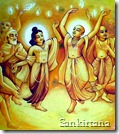 “Free from all contaminations of material desires, the distressed, the inquisitive, the penniless, and the seeker after supreme knowledge can all become pure devotees. But out of them, he who is in knowledge of the Absolute Truth and free from all material desires becomes a really pure devotee of the Lord.” (Shrila Prabhupada, Bhagavad-gita, 7.17 Purport)
“Free from all contaminations of material desires, the distressed, the inquisitive, the penniless, and the seeker after supreme knowledge can all become pure devotees. But out of them, he who is in knowledge of the Absolute Truth and free from all material desires becomes a really pure devotee of the Lord.” (Shrila Prabhupada, Bhagavad-gita, 7.17 Purport)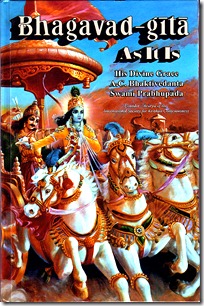
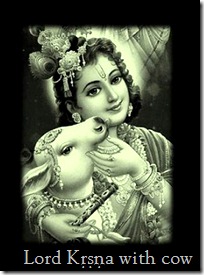 A Brahman realized soul takes the next step into devotional service, or bhakti-yoga. In this discipline, there is still desire and relevant activity, but they are dovetailed with the interests of the Supreme Lord. Just as we are above the dualities of the material nature, so is God. If my identity is not rooted in place of birth, bank balance, or physical relationship to another object, the same holds true for God. As a result the many temporary problems we create are not in His scope of interest.
A Brahman realized soul takes the next step into devotional service, or bhakti-yoga. In this discipline, there is still desire and relevant activity, but they are dovetailed with the interests of the Supreme Lord. Just as we are above the dualities of the material nature, so is God. If my identity is not rooted in place of birth, bank balance, or physical relationship to another object, the same holds true for God. As a result the many temporary problems we create are not in His scope of interest.
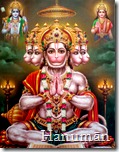 “Parents and other relatives of the Lord achieve all mystic opulences automatically because of their intimate relationship with the Lord. Such opulences include all details of material enjoyment, salvation and mystic powers. Therefore, the devotee of the Lord does not seek them separately, wasting his valuable time in life.” (Shrila Prabhupada, Shrimad Bhagavatam, 2.7.4 Purport)
“Parents and other relatives of the Lord achieve all mystic opulences automatically because of their intimate relationship with the Lord. Such opulences include all details of material enjoyment, salvation and mystic powers. Therefore, the devotee of the Lord does not seek them separately, wasting his valuable time in life.” (Shrila Prabhupada, Shrimad Bhagavatam, 2.7.4 Purport)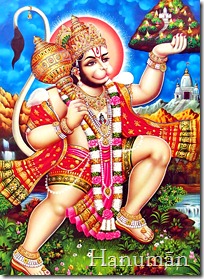 Did Sugriva and Vibhishana strive for sovereignty as the ultimate objective in life? They may or may not have, but nevertheless they couldn’t get full control over their respective kingdoms. Yet from just surrendering to Rama in one second these things were handed over to them. And more importantly, both were in yoga, so while ruling over their kingdoms they only thought of Rama and following His dictates set forth in the Vedic literatures.
Did Sugriva and Vibhishana strive for sovereignty as the ultimate objective in life? They may or may not have, but nevertheless they couldn’t get full control over their respective kingdoms. Yet from just surrendering to Rama in one second these things were handed over to them. And more importantly, both were in yoga, so while ruling over their kingdoms they only thought of Rama and following His dictates set forth in the Vedic literatures.
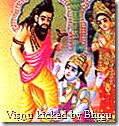 “The Lord has the sign of the foot of bhrigupada as the mark of tolerance. The Lord, therefore, is never affected by any kind of wrath, so how can there be any place for lust, which is less strong than wrath? When lust or desire is not fulfilled, there is the appearance of wrath, but in the absence of wrath how can there be any place for lust? The Lord is known as apta-kama, or one who can fulfill His desires by Himself. He does not require anyone's help to satisfy His desires.” (Shrila Prabhupada, Shrimad Bhagavatam, 2.7.7 Purport)
“The Lord has the sign of the foot of bhrigupada as the mark of tolerance. The Lord, therefore, is never affected by any kind of wrath, so how can there be any place for lust, which is less strong than wrath? When lust or desire is not fulfilled, there is the appearance of wrath, but in the absence of wrath how can there be any place for lust? The Lord is known as apta-kama, or one who can fulfill His desires by Himself. He does not require anyone's help to satisfy His desires.” (Shrila Prabhupada, Shrimad Bhagavatam, 2.7.7 Purport)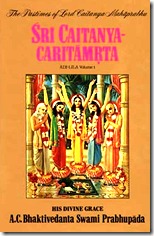
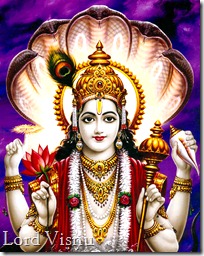 Vishnu took the blow in stride. Since Bhrigu was a brahmana devotee, Vishnu said that He was very humbled to have felt the lotus feet of a brahmana on His chest. He worried that Bhrigu might have gotten hurt by having to kick a chest that was so hard. In this way Vishnu’s supremacy was proven, as His tolerance was unexpected and unbelievable. For the devotee, the Supreme Lord is willing to do anything.
Vishnu took the blow in stride. Since Bhrigu was a brahmana devotee, Vishnu said that He was very humbled to have felt the lotus feet of a brahmana on His chest. He worried that Bhrigu might have gotten hurt by having to kick a chest that was so hard. In this way Vishnu’s supremacy was proven, as His tolerance was unexpected and unbelievable. For the devotee, the Supreme Lord is willing to do anything.
 “The body is only a dead vehicle to be worked by the spirit soul, which is always active and cannot stop even for a moment. As such, the spirit soul has to be engaged in the good work of Krishna consciousness, otherwise it will be engaged in occupations dictated by illusory energy.” (Shrila Prabhupada, Bhagavad-gita, 3.5 Purport)
“The body is only a dead vehicle to be worked by the spirit soul, which is always active and cannot stop even for a moment. As such, the spirit soul has to be engaged in the good work of Krishna consciousness, otherwise it will be engaged in occupations dictated by illusory energy.” (Shrila Prabhupada, Bhagavad-gita, 3.5 Purport)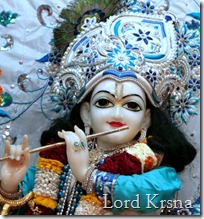 The original Personality of Godhead is described as all-attractive, and so He is addressed as Krishna. He is also the source of transcendental pleasure, and so He is also addressed as Rama. His energy is always tied to Him, and we are part of that energy. The aspects of that energy that follow bhakti-yoga are as worshipable as God, and so the chanting of the maha-mantra, “Hare Krishna Hare Krishna, Krishna Krishna, Hare Hare, Hare Rama Hare Rama, Rama Rama, Hare Hare”, is a great way to practice bhakti-yoga.
The original Personality of Godhead is described as all-attractive, and so He is addressed as Krishna. He is also the source of transcendental pleasure, and so He is also addressed as Rama. His energy is always tied to Him, and we are part of that energy. The aspects of that energy that follow bhakti-yoga are as worshipable as God, and so the chanting of the maha-mantra, “Hare Krishna Hare Krishna, Krishna Krishna, Hare Hare, Hare Rama Hare Rama, Rama Rama, Hare Hare”, is a great way to practice bhakti-yoga.
 “The mahatma is always engaged in different activities of devotional service, as described in the Shrimad-Bhagavatam, hearing and chanting about Vishnu, not a demigod or human being.” (Shrila Prabhupada, Bhagavad-gita, 9.14 Purport)
“The mahatma is always engaged in different activities of devotional service, as described in the Shrimad-Bhagavatam, hearing and chanting about Vishnu, not a demigod or human being.” (Shrila Prabhupada, Bhagavad-gita, 9.14 Purport)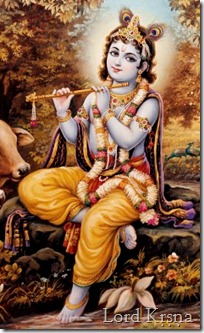 Bhakti-yoga is exclusively reserved for Bhagavan. Within bhakti-yoga, there are different methods, and they are not all required for perfection. Just one implementation done in the proper mood, where desires for material gain and for the elimination of distress are completely absent, brings perfection. Perfection is connection with God, or yoga. The question then remains as to how to implement any or all of the processes.
Bhakti-yoga is exclusively reserved for Bhagavan. Within bhakti-yoga, there are different methods, and they are not all required for perfection. Just one implementation done in the proper mood, where desires for material gain and for the elimination of distress are completely absent, brings perfection. Perfection is connection with God, or yoga. The question then remains as to how to implement any or all of the processes.
 “He who reads this beautiful ashtakam of the sweet pastimes of Kunja-vihari receives the best fortune of attachment to the worship of the lotus feet of the Lord.” (Shrila Rupa Gosvami, Shri Kunja-vihary-astakam, 9)
“He who reads this beautiful ashtakam of the sweet pastimes of Kunja-vihari receives the best fortune of attachment to the worship of the lotus feet of the Lord.” (Shrila Rupa Gosvami, Shri Kunja-vihary-astakam, 9)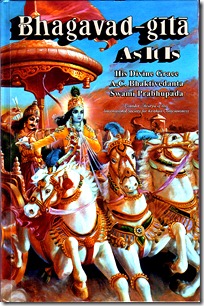
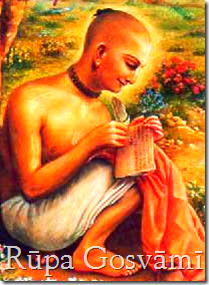 And that fruit is attachment to Krishna’s feet, which are His servants. Attachment to His feet is devotional service, or bhakti-yoga. This is the greatest reward because it is like a wish-fulfilling tree that can be accessed at any time. Whether you are in trouble or in peaceful comfort, chanting, “Hare Krishna Hare Krishna, Krishna Krishna, Hare Hare, Hare Rama Hare Rama, Rama Rama, Hare Hare”, can make you even happier. Chanting and hearing go hand in hand, and they foster remembrance, which is the function of consciousness. Consciousness follows us in each life, like the air carrying aromas.
And that fruit is attachment to Krishna’s feet, which are His servants. Attachment to His feet is devotional service, or bhakti-yoga. This is the greatest reward because it is like a wish-fulfilling tree that can be accessed at any time. Whether you are in trouble or in peaceful comfort, chanting, “Hare Krishna Hare Krishna, Krishna Krishna, Hare Hare, Hare Rama Hare Rama, Rama Rama, Hare Hare”, can make you even happier. Chanting and hearing go hand in hand, and they foster remembrance, which is the function of consciousness. Consciousness follows us in each life, like the air carrying aromas.
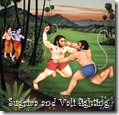 “Sovereignty over the Vanara kingdom was difficult to obtain and was protected by Vali. It was for her sake that Sugriva obtained that kingdom, which is honored throughout the world.” (Hanuman, Valmiki Ramayana, Sundara Kand, 16.11)
“Sovereignty over the Vanara kingdom was difficult to obtain and was protected by Vali. It was for her sake that Sugriva obtained that kingdom, which is honored throughout the world.” (Hanuman, Valmiki Ramayana, Sundara Kand, 16.11)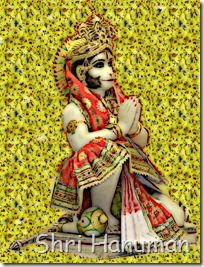 Fortunes turned their way when they ran into a minister to the Vanara-king Sugriva. Vanaras are mostly monkey-like, but in the earlier periods of the creation they have human-like features as well. We learn from the Vedas that the material bodies already exist; they don’t evolve. Each body is composed of a combination of elements in the modes of goodness, passion and ignorance. These modes are present at the beginning of creation, so the different species are like different paintings, different ways to mix the three component qualities. The spirit soul, the occupier within the body, evolves through the different species, but the species themselves aren’t capable of evolving. Life comes from life; matter cannot do anything on its own.
Fortunes turned their way when they ran into a minister to the Vanara-king Sugriva. Vanaras are mostly monkey-like, but in the earlier periods of the creation they have human-like features as well. We learn from the Vedas that the material bodies already exist; they don’t evolve. Each body is composed of a combination of elements in the modes of goodness, passion and ignorance. These modes are present at the beginning of creation, so the different species are like different paintings, different ways to mix the three component qualities. The spirit soul, the occupier within the body, evolves through the different species, but the species themselves aren’t capable of evolving. Life comes from life; matter cannot do anything on its own.
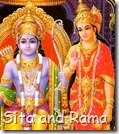 “And Khara was killed in battle, and also Trishira and the highly splendorous Dushana brought down by the self-realized Rama.” (Hanuman, Valmiki Ramayana, Sundara Kand, 16.10)
“And Khara was killed in battle, and also Trishira and the highly splendorous Dushana brought down by the self-realized Rama.” (Hanuman, Valmiki Ramayana, Sundara Kand, 16.10)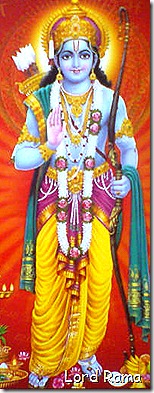 Fighting on foot, Khara hurled a fiery club at Rama, but the Lord shattered it with His arrows. Rama then laughed at Khara, and the demon in turn retorted with his own promises of victory. In the end, Rama took out an arrow given by Indra and shot it at Khara, killing the demon. Khara was the best fighter sent to Janasthana, or the Dandaka forest, and so when Rama killed him it was certainly a big deal. With great pride Hanuman remembers Rama’s killing of the three leading Rakshasas. Similar statements are found elsewhere in Vedic literature, including in the Shrimad Bhagavatam.
Fighting on foot, Khara hurled a fiery club at Rama, but the Lord shattered it with His arrows. Rama then laughed at Khara, and the demon in turn retorted with his own promises of victory. In the end, Rama took out an arrow given by Indra and shot it at Khara, killing the demon. Khara was the best fighter sent to Janasthana, or the Dandaka forest, and so when Rama killed him it was certainly a big deal. With great pride Hanuman remembers Rama’s killing of the three leading Rakshasas. Similar statements are found elsewhere in Vedic literature, including in the Shrimad Bhagavatam.
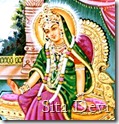 “(For her) fourteen thousand Rakshasas of dreadful deeds were slain in the forest of Janasthana by arrows that were like tongues of fire.” (Hanuman, Valmiki Ramayana, Sundara Kand, 16.9)
“(For her) fourteen thousand Rakshasas of dreadful deeds were slain in the forest of Janasthana by arrows that were like tongues of fire.” (Hanuman, Valmiki Ramayana, Sundara Kand, 16.9)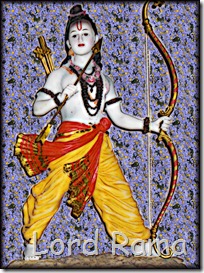 Rama had to perform this task while in the forest of Janasthana. He was there with His wife Sita and His younger brother Lakshmana. Rakshasas are a cruel species; they feast off animal flesh. They will even eat other human beings. It is not that they just go to the restaurant to eat the flesh of animals killed elsewhere; they will do the killing themselves. They don’t attack only the miscreants, either. They go after the most innocent members of society. The saintly priests were living in Janasthana at the time, and so the Rakshasas loved to invade in the nighttime and then find their fare.
Rama had to perform this task while in the forest of Janasthana. He was there with His wife Sita and His younger brother Lakshmana. Rakshasas are a cruel species; they feast off animal flesh. They will even eat other human beings. It is not that they just go to the restaurant to eat the flesh of animals killed elsewhere; they will do the killing themselves. They don’t attack only the miscreants, either. They go after the most innocent members of society. The saintly priests were living in Janasthana at the time, and so the Rakshasas loved to invade in the nighttime and then find their fare.
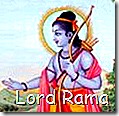 “(For her) fourteen thousand Rakshasas of dreadful deeds were slain in the forest of Janasthana by arrows that were like tongues of fire.” (Hanuman, Valmiki Ramayana, Sundara Kand, 16.9)
“(For her) fourteen thousand Rakshasas of dreadful deeds were slain in the forest of Janasthana by arrows that were like tongues of fire.” (Hanuman, Valmiki Ramayana, Sundara Kand, 16.9)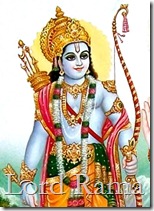 To protect His wife, Rama defeated these 14,000 Rakshasas by Himself. One of them managed to escape back home. Upon reaching there he relayed what he saw to the leader Ravana. After seeing his men so soundly defeated, Ravana created a ruse and took Sita away in secret. Hanuman, a Vanara working for the king Sugriva in Kishkindha, first went to Lanka to find Sita. Seeing her from afar for the first time, Hanuman was amazed at her beauty. He immediately recalled all that Rama had done for her, and he rightly concluded that the effort was worth it.
To protect His wife, Rama defeated these 14,000 Rakshasas by Himself. One of them managed to escape back home. Upon reaching there he relayed what he saw to the leader Ravana. After seeing his men so soundly defeated, Ravana created a ruse and took Sita away in secret. Hanuman, a Vanara working for the king Sugriva in Kishkindha, first went to Lanka to find Sita. Seeing her from afar for the first time, Hanuman was amazed at her beauty. He immediately recalled all that Rama had done for her, and he rightly concluded that the effort was worth it.